MOONs
MOONS鸣志电源型号命名规则
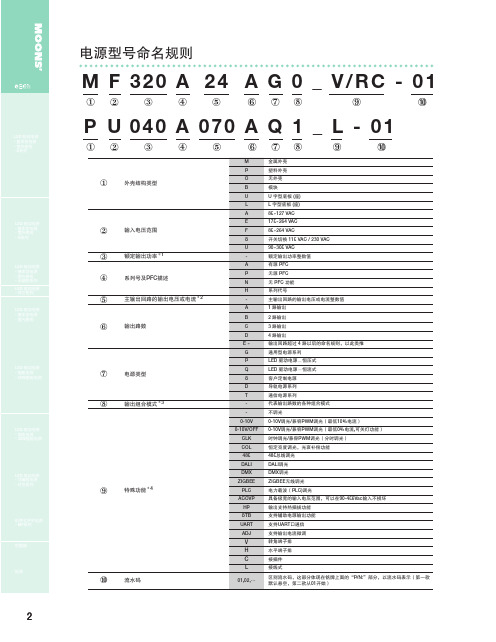
✽3
输出组合
3.1 单路输出默认值为“0”,可省略。“0-9,J-Z”代表不同的输出参数。
例:“PU040A070AQ-L”表示LED电源PU040A系列恒流单路输出,38W700 mA/27-54VDC
3.2 多路输出:代表具体电压或电流规格。“0”表示各路输出电压电流相同。“0-9,J-Z”代表不同的输出组 合。
LED 驱动电源 - 智能电源 - 30W智能电源
LED 驱动电源 - 可编程电源 - 时控系列
机壳式开关电源则
M F 320 A 24 A G 0 _ V/RC - 01
① ② ③ ④ ⑤ ⑥⑦⑧
⑨
⑩
P U 040 A 070 A Q 1 _ L - 01
①② ③ ④ ⑤
命名规则
LED 驱动电源 - 基本型电源 - 室外使用 - A系列
LED 驱动电源 - 基本型电源 - 室外使用 - H系列
LED 驱动电源 - 基本型电源 - 室外使用 - 半灌胶系列 LED 驱动电源 - 其它系列 LED 驱动电源 - 基本型电源 - 室内使用
LED 驱动电源 - 智能电源 - 50W智能电源
命名规则
LED 驱动电源 - 基本型电源 - 室外使用 - A系列
LED 驱动电源 - 基本型电源 - 室外使用 - H系列
LED 驱动电源 - 基本型电源 - 室外使用 - 半灌胶系列 LED 驱动电源 - 其它系列 LED 驱动电源 - 基本型电源 - 室内使用
LED 驱动电源 - 智能电源 - 50W智能电源
区别流水码,这部分体现在铭牌上面的“P/N:”部分,以流水码表示(第一款 默认悬空,第二款从01开始)
� 说明
✽1
某一规格系列输出功率代表值或功率等级;LED电源3位数字标注。
MOONS MS3540MO步进电机驱动器 说明书
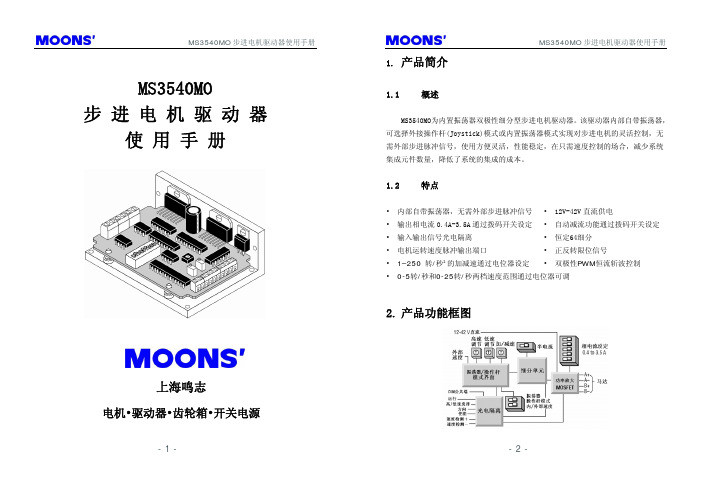
MS3540MO 步进电机驱动器使用手册 下拉方式控制每一路信号的输入,如果输入信号电压是5V,则至少需要提供3mA的电流, 如果输入信号电压是24V,则至少需要提供10mA的电流。大部分CMOS和集电极开路的TTL 器件可以直接兼容驱动器输入接口,典型的PLC和接近开关传感器输出都是兼容的。
下拉电路(NPN) 如果用户设备是下拉电流输出方式的,COM端接用户电源正极;如果用户使用TTL 电路驱动MS3540MO,COM端接用户5V电源总线。COM端不需接到GND上。如果用户使用PLC 或接近开关传感器,需外接电源。
5.3 输入输出接口连接 5.3.1 输入接口连接
MS3540MO采用了光电隔离电路防止外部电路和驱动器间相互干扰,输入信号可以 使用宽的输入电压范围,采用上拉或下拉连接方式接入电路。原理如下图所示:
- 13 -
用户使用5V-24V的输入电源来驱动光耦输入端的发光二极管。控制逻辑以上拉或
- 14 -
上拉电路(PNP) 如果用户设备输出信号能够提供输出电流,用户可将输出信号直接接到驱动器的 输入信号端,COM端接到用户的GND上。 注:当光耦输入端有电流流过时,输入信号打开;当光耦输入端没有电流流过时, 输入信号关闭。当COM端和信号输入端是相同电平或输入端悬空不接时,输入信号关闭。
EN信号打开将关断步进电机的电流,内部控制逻辑将继续运行,驱动器会记忆在 功率器件关断时电机的相序位置。但是由于电流在电机线圈中缓慢消失和负载的惯性, 步进电机在EN信号打开后还是会有轻微的移动。如果用户不使用关断功率放大功能, 建议EN信号悬空。
- 12 -
MS3540MO 步进电机驱动器使用手册
5.2 电机连接
警告:将电机接到驱动器时,请先确认供电电源已关闭。确认未 使用的电机引线未与其他物体发生短路。在驱动器通电期间,不 能断开电机。不要将电机引线接到地上或电源上。 电机与驱动器的连接, 四线,六线,八线电机的连接方式叙述如下:
The Moon 月球(英)
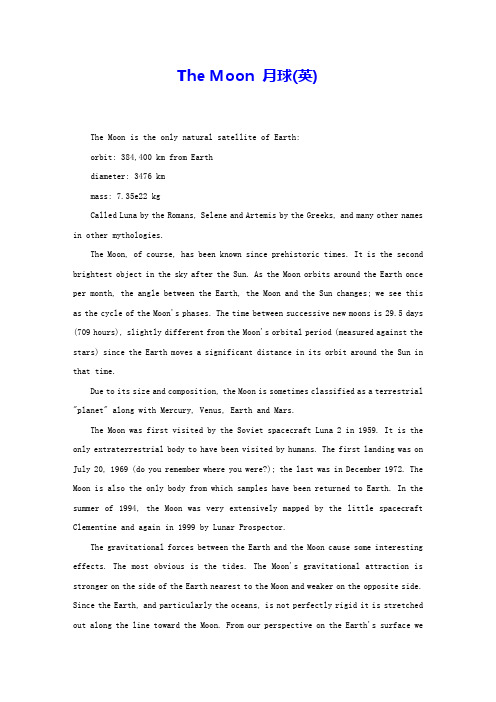
The Moon 月球(英)The Moon is the only natural satellite of Earth:orbit: 384,400 km from Earthdiameter: 3476 kmmass: 7.35e22 kgCalled Luna by the Romans, Selene and Artemis by the Greeks, and many other names in other mythologies.The Moon, of course, has been known since prehistoric times. It is the second brightest object in the sky after the Sun. As the Moon orbits around the Earth once per month, the angle between the Earth, the Moon and the Sun changes; we see this as the cycle of the Moon's phases. The time between successive new moons is 29.5 days (709 hours), slightly different from the Moon's orbital period (measured against the stars) since the Earth moves a significant distance in its orbit around the Sun in that time.Due to its size and composition, the Moon is sometimes classified as a terrestrial "planet" along with Mercury, Venus, Earth and Mars.The Moon was first visited by the Soviet spacecraft Luna 2 in 1959. It is the only extraterrestrial body to have been visited by humans. The first landing was on July 20, 1969 (do you remember where you were?); the last was in December 1972. The Moon is also the only body from which samples have been returned to Earth. In the summer of 1994, the Moon was very extensively mapped by the little spacecraft Clementine and again in 1999 by Lunar Prospector.The gravitational forces between the Earth and the Moon cause some interesting effects. The most obvious is the tides. The Moon's gravitational attraction is stronger on the side of the Earth nearest to the Moon and weaker on the opposite side. Since the Earth, and particularly the oceans, is not perfectly rigid it is stretched out along the line toward the Moon. From our perspective on the Earth's surface wesee two small bulges, one in the direction of the Moon and one directly opposite. The effect is much stronger in the ocean water than in the solid crust so the water bulges are higher. And because the Earth rotates much faster than the Moon moves in its orbit, the bulges move around the Earth about once a day giving two high tides per day. (This is a greatly simplified model; actual tides, especially near the coasts, are much more complicated.)But the Earth is not completely fluid, either. The Earth's rotation carries the Earth's bulges slightly ahead of the point directly beneath the Moon. This means that the force between the Earth and the Moon is not exactly along the line between their centers producing a torque on the Earth and an accelerating force on the Moon. This causes a net transfer of rotational energy from the Earth to the Moon, slowing down the Earth's rotation by about 1.5 milliseconds/century and raising the Moon into a higher orbit by about 3.8 centimeters per year. (The opposite effect happens to satellites with unusual orbits such as Phobos and Triton).The asymmetric nature of this gravitational interaction is also responsible for the fact that the Moon rotates synchronously, i.e. it is locked in phase with its orbit so that the same side is always facing toward the Earth. Just as the Earth's rotation is now being slowed by the Moon's influence so in the distant past the Moon's rotation was slowed by the action of the Earth, but in that case the effect was much stronger. When the Moon's rotation rate was slowed to match its orbital period (such that the bulge always faced toward the Earth) there was no longer an off-center torque on the Moon and a stable situation was achieved. The same thing has happened to most of the other satellites in the solar system. Eventually, the Earth's rotation will be slowed to match the Moon's period, too, as is the case with Pluto and Charon.Actually, the Moon appears to wobble a bit (due to its slightly non-circular orbit) so that a few degrees of the far side can be seen from time to time, but the majority of the far side (left) was completely unknown until the Soviet spacecraft Luna 3 photographed it in 1959. (Note: there is no "dark side" of the Moon; all parts of the Moon get sunlight half the time (except for a few deep craters near the poles). Some uses of the term "dark side" in the past may have referred to the far side as"dark" in the sense of "unknown" (eg "darkest Africa") but even that meaning is no longer valid today!)The Moon has no atmosphere. But evidence from Clementine suggested that there may be water ice in some deep craters near the Moon's south pole which are permanently shaded. This has now been reinforced by data from Lunar Prospector. There is apparently ice at the north pole as well. A final determination will probably come from NASA's Lunar Reconnaissance Orbiter, scheduled for 2008.The Moon's crust averages 68 km thick and varies from essentially 0 under Mare Crisium to 107 km north of the crater Korolev on the lunar far side. Below the crust is a mantle and probably a small core (roughly 340 km radius and 2% of the Moon's mass). Unlike the Earth, however, the Moon's interior is no longer active. Curiously, the Moon's center of mass is offset from its geometric center by about 2 km in the direction toward the Earth. Also, the crust is thinner on the near side.There are two primary types of terrain on the Moon: the heavily cratered and very old highlands and the relatively smooth and younger maria. The maria (which comprise about 16% of the Moon's surface) are huge impact craters that were later flooded by molten lava. Most of the surface is covered with regolith, a mixture of fine dust and rocky debris produced by meteor impacts. For some unknown reason, the maria are concentrated on the near side.Most of the craters on the near side are named for famous figures in the history of science such as Tycho, Copernicus, and Ptolemaeus. Features on the far side have more modern references such as Apollo, Gagarin and Korolev (with a distinctly Russian bias since the first images were obtained by Luna 3). In addition to the familiar features on the near side, the Moon also has the huge craters South Pole-Aitken on the far side which is 2250 km in diameter and 12 km deep making it the the largest impact basin in the solar system and Orientale on the western limb (as seen from Earth; in the center of the image at left) which is a splendid example of a multi-ring crater.A total of 382 kg of rock samples were returned to the Earth by the Apollo and Luna programs. These provide most of our detailed knowledge of the Moon. They are particularly valuable in that they can be dated. Even today, more than 30 years afterthe last Moon landing, scientists still study these precious samples.Most rocks on the surface of the Moon seem to be between 4.6 and 3 billion years old. This is a fortuitous match with the oldest terrestrial rocks which are rarely more than 3 billion years old. Thus the Moon provides evidence about the early history of the Solar System not available on the Earth.Prior to the study of the Apollo samples, there was no consensus about the origin of the Moon. There were three principal theories: co-accretion which asserted that the Moon and the Earth formed at the same time from the Solar Nebula; fission which asserted that the Moon split off of the Earth; and capture which held that the Moon formed elsewhere and was subsequently captured by the Earth. None of these work very well. But the new and detailed information from the Moon rocks led to the impact theory: that the Earth collided with a very large object (as big as Mars or more) and that the Moon formed from the ejected material. There are still details to be worked out, but the impact theory is now widely accepted.The Moon has no global magnetic field. But some of its surface rocks exhibit remanent magnetism indicating that there may have been a global magnetic field early in the Moon's history.With no atmosphere and no magnetic field, the Moon's surface is exposed directly to the solar wind. Over its 4 billion year lifetime many ions from the solar wind have become embedded in the Moon's regolith. Thus samples of regolith returned by the Apollo missions proved valuable in studies of the solar wind.。
fullmoon
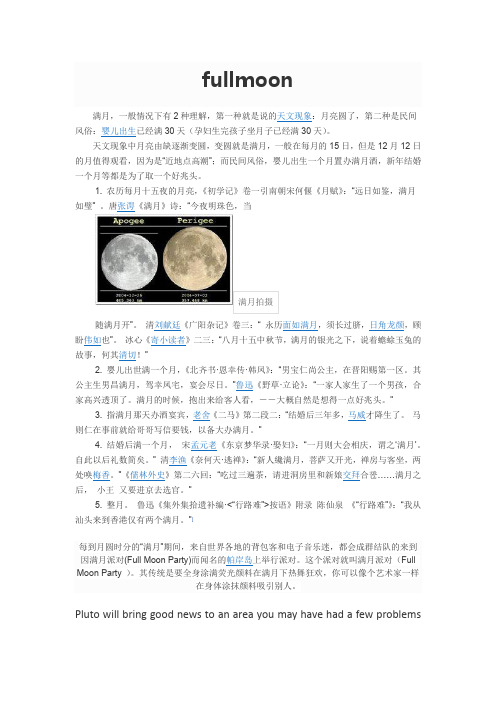
璧‖ 。
唐张谔《满月》诗:―今夜明珠色,当满月拍摄Pluto will bring good news to an area you may have had a few problemswith earlier,at the full moon.请看这句话,从you may 到full moon都是用来形容area的吗?就是翻译成“冥王星会给你的一个地方带来好消息,(在这个地方)你可能之前有一些问题,(问题发生在)在满月时.”是这样吗?这是有多处省略么?可否详解一下呢,ishing / broadcasting project,matters relating to academia and the pursuit of higher education,international relations and citizenship-work issues,import-export,and overseas travel.(Those are all very exciting areas!)意思:冥王星带来好消息限制到一个区域可以有一些问题,早些时候,在满月的夜晚。
月圆之夜,冥王星将会指引你走出我们的困惑!Full moonFrom Wikipedia, the free encyclopediaFor other uses, see Full moon (disambiguation), Harvest moon (disambiguation), and Hunter's moon (disambiguation)."Strawberry Moon" redirects here. For the jazz album by Grover Washington Jr., see Strawberry Moon (album).The November 14, 2016 supermoon was 356,511 km (221,526 mi) away[1] from the center of Earth, the closest occurrence since 1948. It will not be closer again until 2034.[2]Photograph of the full moon as viewed through a 235 mm (9.25 in) Schmidt-Cassegrain telescope. The moon was near its greatest northern ecliptic latitude, so the southern craters are especially prominent.Photograph of full moon during the total lunar eclipse of 28 September 2015.A full moon is the lunar phase that occurs when the Moon is completely illuminated as seen from Earth. This occurs when Earth is located directly between the Sun and the Moon (more exactly, when the ecliptic longitudes of the Sun and Moon differ by 180 degrees). This means that the hemisphere of the Moon that is facing Earth (the near side) is almost fully illuminated by the Sun and appears round (while the far side is almostcompletely unlit). When the full moon moves into Earth's shadow, a lunar eclipse occurs, and all or part of the Moon's face may appear reddish due to the Rayleigh scattering of blue light in Earth's atmosphere.[3][4][5]Lunar eclipses can occur only at full moon, where the Moon's orbit allows it to passthrough Earth's shadow. Lunar eclipses do not occur every month because the Moon usually passes above or below Earth's shadow, which is mostly restricted to the ecliptic plane. Lunar eclipses can occur only when the full moon occurs near the two nodes of the orbit, either the ascending or descending node. This causes eclipses to only occur about every 6 months, and often 2 weeks before or after a solar eclipse at new moon at the opposite node.The time interval between similar lunar phases—the synodic month—averages about29.53 days. Therefore, in those lunar calendars in which each month begins on the newmoon, the full moon falls on either the 14th or 15th of the lunar month. Because calendar months have a whole number of days, lunar months may be either 29 or 30 days long.Contents[hide]∙1Characteristicso 1.1Formula∙2In folklore and traditiono 2.1Full moon names▪ 2.1.1Harvest and hunter's moons▪ 2.1.2Farmers' Almanacso 2.2Hindu full moon festivals∙3Lunar and lunisolar calendarso 3.1Intercalary months▪ 3.1.1Blue moon∙4See also∙5References∙6External linksCharacteristics[edit]A full moon is often thought of as an event of a full night's duration. This is somewhatmisleading because its phase seen from Earth continuously waxes or wanes (though much too slowly to notice in real time with the naked eye). Its maximum illuminationoccurs at the moment waxing has stopped. For any given location, about half of these maximum full moons may be visible, while the other half occurs during the day, when the full moon is below the horizon.Many almanacs list full moons not only by date, but also by their exact time, usuallyin Coordinated Universal Time (UTC). Typical monthly calendars that include lunar phases may be offset by one day when used in a different time zone.Full moon is generally a suboptimal time to conduct astronomical observations because the bright sunlight reflected by the Moon then outshines the apparently dimmer stars.On 12 December 2008, the full moon occurred closer to the Earth than it had been at any time for the previous 15 years, called a supermoon.[6]On 19 March 2011, another full supermoon occurred, closer to the Earth than at any time for the previous 18 years.[7]On 14 November 2016, a full supermoon occurred closer to the Earth than at any time for the previous 68 years.[8]Formula[edit]The date and approximate time of a specific full moon (assuming a circular orbit) can be calculated from the following equation:[9]where d is the number of days since 1 January 2000 00:00:00 in the TerrestrialTime scale used in astronomical ephemerides; for Universal Time (UT) add thefollowing approximate correction to d:dayswhere N is the number of full moons since the first full moon of 2000. The truetime of a full moon may differ from this approximation by up to about 14.5 hoursas a result of the non-circularity of the moon's orbit.[10] See New moon for anexplanation of the formula and its parameters.The age and apparent size of the full moon vary in a cycle of just under14 synodic months, which has been referred to as a full moon cycle.In folklore and tradition[edit]See also: List of lunar deities and Lunar effectFull moon rising, seen through the Belt of VenusFull moons are traditionally associated with temporal insomnia (inability to sleep), insanity (hence the terms lunacy and lunatic) and various "magical phenomena" such as lycanthropy. Psychologists, however, have found that there is no strong evidence for effects on human behavior around the time of a full moon.[11] They find that studies are generally not consistent, with some showing a positive effect and others showing a negative effect. In one instance, the 23 December 2000 issue of the British Medical Journal published two studies on dog bite admission to hospitals in England and Australia. The study of the Bradford Royal Infirmary found that dog bites were twice as common during a full moon, whereas the study conducted by the public hospitals in Australia found that they were less likely. All this is relevant to canine rather than human behavior.Full moon names[edit]Historically, month names are names of moons (lunations, not necessarily full moons) in lunisolar calendars. Since the introduction of the solar Julian calendar in the Roman Empire, and later the Gregorian calendar worldwide, month names have ceased to be perceived as "moon names". The traditional Old English month names were equated with the names of the Julian calendar from an early time (soon after Christianization, according to the testimony of Bede ca. AD 700).Some full moons have developed new names in modern times, e.g., the blue moon, and the names "harvest moon" and "hunter's moon" for the full moons of autumn.Harvest and hunter's moons[edit]"Harvest moon" and "Hunter's moon" redirect here. For other uses, see Harvest moon (disambiguation) and Hunter's moon (disambiguation).A harvest moon. Its orange color is due to its closeness to the horizon, rather than being unique to harvest moons.[12]The "harvest moon" and "hunter's moon" are traditional terms for the full moons occurring during late summer and in the autumn, in the northern hemisphere usually in September and October respectively. The "harvest moon" is the full moon closest to the autumnal equinox (22 or 23 September), coming anywhere from two weeks before to two weeks after that date.[13] The "hunter's moon" is the full moon following it. The names are recorded from the early 18thcentury.[14]The Oxford English Dictionary entry for "harvest moon" cites a 1706 reference, and for "hunter's moon" a 1710 edition of The British Apollo, where the term is attributed to "the country people" (The Country People call this the Hunters-Moon.) The names became traditional in American folklore, where they are now often popularly attributed to the Native Americans.[15] The Feast of the Hunters' Moon is a yearly festival in West Lafayette, Indiana, held in late September or early October each year since 1968.[16] In 2010, the Harvest moon occurred on the night of equinox itself (some 5 1⁄2 hours after the point of equinox) for the first time since 1991.[17][18]All full moons rise around the time of sunset. Because the moon moves eastward among the stars faster than the sun its meridian passage is delayed, causing it to rise later each day – on average by about 50.47 minutes.[19] The harvest moon and hunter's moon are unique because the time difference between moonrises on successive evenings is much shorter than average. The moon rises approximately 30 minutes later from one night to the next, as seen from about 40 degrees N or S latitude. (This is because a full moon in September appears to move not straight east but north-east in the sky.) Thus, there is no long period of darkness between sunset and moonrise for several days following the actual date of the full moon.[20]Farmers' Almanacs[edit]The Maine Farmers' Almanac from c. the 1930s began to publish Native American "Indian" full moon names. The Farmers' Almanac (since 1955 published in Maine, but not the same publication as the Maine Farmers' Almanac) continues to do so.[21]An early list of "Indian month names" was published in 1918 by Daniel Carter Beard in his The American Boy's Book of Signs, Signals and Symbols for use by the boy scouts. Beard's "Indian" month names were:[22]∙January: Difficulty, Black Smoke∙February: Raccoon, Bare Spots on the Ground∙March: Wind, Little Grass, Sore-Eye∙April: Ducks, Goose-Eggs∙May: Green Grass, Root-Food∙June: Corn-Planting, Strawberry∙July: Buffalo (Bull), Hot Sun∙August: Harvest, Cow Buffalo∙September: Wild Rice, Red Plum∙October: Leaf-Falling, Nuts∙November: Deer-Mating, Fur-Pelts∙December: Wolves, Big MoonSuch names have gained currency in American folklore. They appear in print more widely outside of the almanac tradition from the 1990s in popular publications about the Moon. Mysteries of the Moon by Patricia Haddock ("Great Mysteries Series", Greenhaven Press, 1992) gave an extensive list of such names along with the individual tribal groups they were supposedly associated with.[23]Haddock supposes that certain "Colonial American" moon names were adopted from Algonquian languages (which were formerly spoken in the territory of New England), while others are based in European tradition (e.g., the Colonial American names for the May moon, "Milk Moon", "Mother's Moon", "Hare Moon" have no parallels in the supposed native names, while the name of November, "Beaver Moon" is supposedly based in the Algonquin).The individual names given in Farmers' Almanac include:[clarification needed]∙January: "Wolf Moon" (this is the name of December in Beard 1918)[24] also "Old Moon"∙February: "Snow Moon", also "Hunger Moon"∙March: "Worm Moon", "Crow Moon", "Sap Moon", "Lenten Moon"∙April: "Seed Moon", "Pink Moon", "Sprouting Grass Moon", "Egg Moon" (c.f."Goose-Egg" in Beard 1918), "Fish Moon"∙May: "Milk Moon", "Flower Moon", "Corn Planting Moon"∙June: "Mead Moon", "Strawberry Moon" (c.f. Beard 1918), "Rose Moon", "Thunder Moon"∙July: "Hay Moon", "Buck Moon", "Elk Moon", "Thunder Moon"∙August: "Corn Moon", "Sturgeon Moon", "Red Moon", "Green Corn Moon", "Grain Moon"∙September: "Harvest Moon", "Full Corn Moon",∙October: "Hunter's moon", "Blood Moon"/"Sanguine Moon"∙November: "Beaver Moon", "Frosty Moon"∙December: "Oak Moon", "Cold Moon", "Long Night's Moon"The Long Night's Moon is the last of the year and the closest to the winter solstice.[25]In June 2016 the so-called "Strawberry Moon" coincided with the Summer solstice for the first time since 1967, and will not return for another 46 years.[26]"Ice moon" is also used to refer to the first full moon of February or January. Hindu full moon festivals[edit]See also: PurnimaIn Hinduism, most festivals are celebrated on auspicious days. Many of the Hindu festivals are celebrated on days with a full moon at night. Different parts of India celebrate the same day with different names, as listed below:1. Chaitra Purnima - Gudi Padua, Yugadi, Ugadi, Hanuman Jayanti (April15, 2014)[27]2. Vaishakh Purnima - Narasimh Jayanti, Buddha Jayanthi (May 14,2014)[28]3. Jyeshtha Purnima - Vat Savitri Vrat Vat Purnima (June 8, 2014)[29]4. Guru Purnima - the full moon of the Ashadh month5. Vyas Purnima - important day for starting education and honoringteachers[29]6. Shravan Purnima - good day for starting Upanayan day, AvaniAvittam, Raksha Bandhan- conceptually Onam also comes on this day.7. Bhadrapad Purnima - start of Pitrupaksha, Madhu Purnima8. Ashvin Purnima - Sharad Purnima9. Kartik Poornima - Thrukkarthika10. Margasirsha Purnima - Thiruvathira, Dathatreya Jayanthi11. Pushya Purnima - Thaipusam, Shakambharee Purnima12. Magha Purnima13. Phalguna Purnima - HoliLunar and lunisolar calendars[edit]Main article: Lunar calendarMost pre-modern calendars the world over were lunisolar, combining the solar year with the lunation by means of intercalary months.[32][33] The Julian calendar abandoned this method in favour of a purely solar reckoning while conversely the 7th-century Islamic calendar opted for a purely lunar one.A continuing lunisolar calendar is in the Hebrew calendar. Evidence of this is noted in the dates of Passover and Easter in Judaism and Christianity, respectively. The date of the Jewish Rosh Hashana and Sukkot festivals along with all other Jewish holidays are dependent on the dates of the new moons.[34]Intercalary months[edit]Main article: Intercalary monthIn lunisolar calendars, an intercalary month occurs 7 times in the 19 years ofthe Metonic cycle, or on average every 2.7 years (19/7). In the Hebrew Calendar this is noted with a periodic extra month of Adar in the early spring.Blue moon[edit]Further information: Blue moonIn the modern system of "traditional" full moon names tied tothe solstice and equinox points, a supernumerary full moon in such a period is called a blue moon. The term "blue moon" used in this sense may date to as early as the 16th century, but it became well known in the United States due tothe Farmers' Almanac (published since 1818).[35]According to the Farmers' Almanac, a "blue moon" is the third full moon in any period between either solstice and equinox, or between equinox and solstice, (calculated using the mean tropical year), which contains four fullmoons.[36] These seasons are equal in length, unlike the astronomical ones, which vary in length depending on the Earth's speed in its elliptical orbit round the sun.To compare, in 1983 the equal length seasons began at 1.48 AM on 23 March,9.15 AM on 22 June, 4.42 PM on 21 September and 12.10 AM on 22 December,while the astronomical seasons began at 4.39 AM on 21 March, 11.09 PM on 21 June, 2.42 PM on 23 September and 10.30 AM on 22 December (all times GMT).Due to a misinterpretation of this definition in the March 1946 Sky &Telescope magazine, "blue moon" has also been used in the sense of "thesecond full moon in any month which contains two full moons (this usage has been noted as "erroneous" by Sky & Telescope in 1999).[37] According to either definition, "blue moons" occur with the average frequency of intercalary months, seven times in 19 years, the Farmers' Almanac system of "full moon names"effectively defining a lunisolar calendar.See also[edit]∙Moon portal∙Lunar eclipse∙Lunar phase∙Month∙Near side of the Moon∙New moon∙Orbit of the MoonReferences[edit]1. Jump up^"“SUPER MOON” EXCEPTIONAL. BRIGHTEST MOON IN THE SKYOF NORMANDY, MONDAY, NOVEMBER 14". 2016-11-12.Retrieved2017-02-08.2. Jumpup^/2016/11/10/moongazers-delight-biggest-supermoon-in-decades-looms-large-Sunday-night/3. Jump up^Seidelmann, P. Kenneth (2005). "Phases of the Moon".ExplanatorySupplement to the Astronomical Almanac. University Science Books.p. 478. ISBN0-935702-68-7. They are the times when the excess of the Moon'sapparent geocentric ecliptic longitude λM over the Sun's apparent geocentricecliptic longitude is 0, 90, 180, or 270 ...4. Jump up^"Celestial Alignment without Lunar Eclipse; from google (full moonearth block sunlight) result 2".5. Jump up^"tiled from the ecliptic by about 5 degrees; from google (full moon earthblock sunlight) result 3".6. Jump up^Phillips, Tony (9 December 2008). "Biggest Full Moon of theYear". Science@NASA. Retrieved 4 March 2010.7. Jump up^Phillips, Tony (16 March 2011). "Super Full Moon".Science@NASA.Retrieved 13 March 2014.8. Jump up^Phillips, Tony (14 October 2016). "Super Full Moon".Science@NASA.Retrieved 13 November 2016.9. Jump up^Meeus, Jean (1998). "Phases of the Moon". AstronomicalAlgorithms (2nd ed.). Richmond, Virginia: Willmann-Bell.pp. 349–354. ISBN0-943396-61-1.10. Jump up^Meeus, Jean (2002). "The Duration of the Lunation". MoreMathematical Astronomy Morsels. Richmond, Virginia: Willmann-Bell.pp. 19–31. ISBN0-943396-74-3.11. Jump up^"Full Moon Effect On Behavior Minimal, Studies Say".NationalGeographic News. 6 February 2004.12. Jump up^Percy, John (27 September 2010). "Why is the harvest moon so bigand orange?". University of Toronto.13. Jump up^"What is a Harvest Moon?". Old Farmer's Almanac.14. Jump up^ see James Ferguson, Astronomy explained upon Sir Isaac Newton'sprinciples,: and made easy to those who have not studied mathematics, 1756, p.128. "harvest moon" is also the cognate of herbist-mānod, the Old HighGerman name of November recorded in Vita Karoli Magni, ch. 29.15. Jump up^Neata, Emil. "The Hunter's Moon". Night Sky Info. Retrieved29December 2008.16. Jump up^"Feast of the Hunters' Moon". Tippecanoe County HistoricalAssociation.17. Jump up^Phillips, Tony (22 September 2010). "Watch out for the Super HarvestMoon". NASA Science. Retrieved 13 September 2011.18. Jump up^Maddox, Jack (22 September 2010). "Super Harvest Moon: Autumnphenomenon is a rare treat". CNN. Retrieved 13 September 2011.19. Jump up^ (1440/(29.531)=50.47 minutes)20. Jump up^Larry McNish (2007). "RASC Calgary Centre - Sunset andMoonrise". This gives a graph showing the effect as seen from Calgary, for the whole of the year 2007.21. Jump up^"Full Moon Names and Their Meanings". Farmers'Almanac.(2007); "Full Moons: What's in a Name?". National Geographic.Retrieved 12 January 2012.22. Jump up^ Beard 1918, pp. 78–80. "The Indians' Moons naturally vary in thedifferent parts of the country, but by comparing them all and striking an average as near as may be, the moons are reduced to the following"23. Jump up^ repeated in The Moon Book by Kim Long (1998:102ff.) Alsoin Llewellyn's 1996 Moon Sign Book (1995).24. Jump up^ "Wolf Moon" is attributed to the Algonquin by Haddock (1992); theactual Algonquin name for that moon is squochee kesos or "sun has not strength to thaw". The New England historical & genealogical register and antiquarian journal: v. 10 The Sioux do mention wolves in their name for January, whichmeans "when wolves run together". American Indian Moons; they also refer to that moon as the "moon of the strong cold" or "frost in the teepee". Other tribes had different names for the moons. See also Indian Moons, Days & OtherCalendar Stuff American Indian Moons25. Jump up^Dance, Scott. "'Long Night's Moon' comes on Christmas for first timesince 1977," The Baltimore Sun, Wednesday, December 23, 2015.26. Jump up^[1]27. Jumpup^/purnima/chaitra/chaitra-purnima-date-time.ht ml?year=201428. Jumpup^/purnima/vaishakha/vaishakha-purnima-date-t ime.html?year=201429. ^ Jump upto:a b /festivals/guru-purnima/guru-purnima-date-ti me.html?year=201430. Jump up^Rare Full Moon on Christmas Day, NASA31. Jump up^Ask Tom: How unusual is a full moon on Christmas Day?32. Jump up^ see e.g., Blackburn, Bonnie; et al. (1999). The Oxford Companion tothe Year. Oxford University Press. ISBN0-19-214231-3.33. Jump up^Reingold, Edward M.; et al. (2001). Calendrical Calculations: TheMillennium Edition. Cambridge University Press. ISBN0-521-77752-6.34. Jump up^Leviticus 23:4-7, 33-35.35. Jump up^ The saying "once in a blue moon" meaning "very rarely" is recordedsince the 1820s. The term "blue moon" is recorded in 1528, in the couplet Ochurche men are wyly foxes [...] Yf they say the mone is blewe / We must beleve that it is true / Admittynge their interpretacion. (Thomas Wolsey, Rede me and be nott wrothe, for I say no thynge but trothe ed. 1871 p. 114); it isn't clear however if this refers to intercalation.36. Jump up^ Farmers' Almanac, "What is a blue moon?", 24 August 2009,available at [2].37. Jump up^Sky and Telescope "What's a blue moon?"。
戳爷Forhim中英文歌词

-----d all the silver moons 甚至可以忘记漫天流星和银辉月色We've been making shades of purple out of red and blue就算没有音符我们也能谱写属于我们的美妙乐章Sickeningly sweet like honey don't need money 亲爱的,拥有这如痴如醉的甜蜜我可以不要钱财All I need is you 我想要的只有你All I need is you我想要的只有你 Eat a pill stay and chill you don't needago 吃下爱情的药丸感受激情,你不要离开I'm about to bring emo back if you leave my home 假若你离开我家,我会召回激烈的爱I'd panic at the disco and you'd rather watch a TV show我在舞池中惊慌失措,你却悠然享受电视节目 Then ill squeeze your booty real hard 于是我发疯地揉捏 likeI'm kneading dough抚摸你的身体 Pizza boy I'm speeding for ya披萨男孩我将飞快朝你前进 We canna get married tonight if you really wanna如果你愿意,今晚我们就私定终身 Me in a cheap suit like a sleazy lawyer我穿着低廉的礼服像个潦倒的律师And if you break my lil heart it'd be an honour 你不费吹灰之力就能击破我沦陷的心You don't have to say I love you to say I love you你甚至不用说,我爱你Forget all the shooting stars and all the silver moons甚至可以忘记漫天流星和银辉月色We've been making shades of purple out of red and blue就算没有音符我们也能谱写属于我们的美妙乐章Sickeningly sweet like honey don't need money。
MOONS MS2035MXD步进电机驱动器 说明书

- 1 -MS2035MXD步 进 电 机 驱 动 器使 用 手 册上海鸣志电机•驱动器•齿轮箱•开关电源- 2 -1.产品简介1.1概述MS2035MXD可独立驱动两台步进电机,为双极细分型步进电机驱动器。
该驱动器内部自带振荡器,可选择脉冲/方向模式或内部自带振荡器模式(外部模拟量输入控制转速)操作,使用方便灵活,性能稳定,成本低。
1.2 特点• 可独立驱动两台步进电机• 12V-35V 直流供电• 输出相电流0.1A-2A,(通过软件配置) • 自动减流功能(通过软件配置) • 15档细分(通过软件配置)• H 桥双极恒流驱动• 输入信号光隔离,脉冲响应频率可达1MHz • 步进脉冲、方向和使能信号控制 • 0-5V 模拟量输入转速控制• 光电隔离的可编程输出信号2.产品功能框图(单路)- 3 - 3. 性能指标3.1电气指标说明 最小值 典型值 最大值 单位 供电电压 12 - 35 VDC 输出电流 0.1 - 2 A 控制信号输入电流 5 10 15 mA 步进脉冲频率 0 - 1000 KHz 步进脉冲最小宽度 0.5 - - us 转向信号最小宽度 2 - - us 模拟输入电压 0 - 5 V 模拟输入阻抗1-10KΩ3.2 环境指标冷却方式自然冷却或强制冷却使用场合 避免粉尘、油雾及腐蚀性气体 推荐工作环境温度0ºC –+50ºC最高环境湿度 90%RH9(不能结露或有水珠) 震动 5.9m/s 2 max 使用环境 存储温度-20ºC - +85ºC4. 接口与接线参照如下接口关系图,使用MS2035MXD控制器产品,需要做以下准备: • 12-35 VDC 直流电源 • 相匹配的步进电机- 4 -• 运行Microsoft Windows95,98,NT,Me,2000 or XP 的PC(语言需设置为英文,设置方法:控制面板Æ区域和语言选项Æ区域选项Æ标准和格式栏目的自定义设置成“英语(美国)”;高级栏目中的非Unicode 程序的语言设置成“英语(美国)”) • eXposition 软件(附带光盘提供) • 编程电缆如果使用脉冲/方向模式,则需提供: • 步进脉冲信号源• 如电机需双向运转,则需提供转向控制信号如果使用内部振荡器模式,则需提供: • 启停信号,方向信号• 模拟的转速信号或用于转速调节的电位器- 5 - 4.1 电源连接如果电源输出没有保险丝或没有电流限制功能,需要在驱动器和电源间接上4A 的快速保险丝,保险丝装在电源正极引线端。
moon的意思用法总结
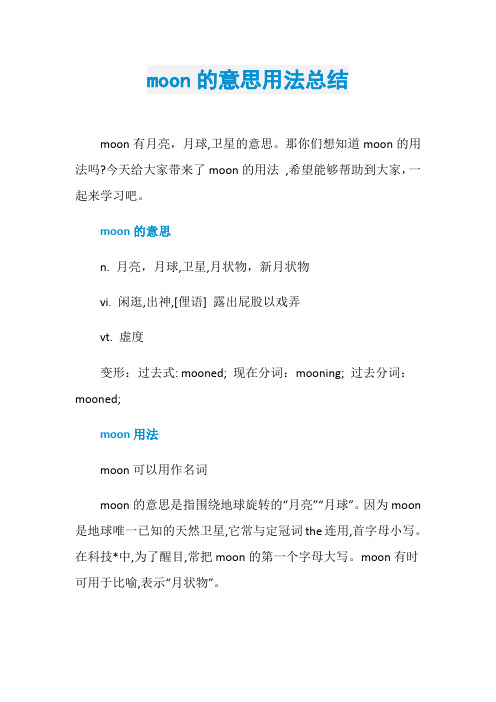
moon的意思用法总结moon有月亮,月球,卫星的意思。
那你们想知道moon的用法吗?今天给大家带来了moon的用法,希望能够帮助到大家,一起来学习吧。
moon的意思n. 月亮,月球,卫星,月状物,新月状物vi. 闲逛,出神,[俚语] 露出屁股以戏弄vt. 虚度变形:过去式: mooned; 现在分词:mooning; 过去分词:mooned;moon用法moon可以用作名词moon的意思是指围绕地球旋转的“月亮”“月球”。
因为moon 是地球唯一已知的天然卫星,它常与定冠词the连用,首字母小写。
在科技*中,为了醒目,常把moon的第一个字母大写。
moon有时可用于比喻,表示“月状物”。
moon在表示月亮某时间出现等某种状态时,可与不定冠词连用,此时其前常有形容词修饰,作此解时常用单数。
在文学语言中, moon也可用作复数,强调月亮不断地重复出现,衬托出人物内心情绪和思想状况。
在诗歌中, moon可作“月”解。
moon用作名词的用法例句The moon goes round the earth.月亮绕着地球转。
Last night there was a full moon.昨晚是满月。
The moon peeped out from behind the clouds.月亮从云层中隐现。
moon用法例句1、June always rhymes with moon in old love songs.在老情歌中June总是和moon成韵。
2、In Norse mythology the moon is personified as male.在斯堪的纳维亚神话里,月亮被赋予了男性身份。
3、The half moon is hidden behind some wispy clouds.半轮月亮躲在淡淡的云彩之后。
moon词组| 习惯用语on the moon 在月球上full moon 满月moon cake n. 月饼new moon 新月blue moon 不可能或稀有的时期或事情bright moon 明月,皓月;明月心crescent moon 新月;盈月;娥眉月moon festival 中秋节half moon 半月;半月形over the moon 兴高采烈;欣喜若狂moon river 月亮河(电影《第凡内早餐》主题曲) fly to the moon 飞向月亮sun moon lake 台湾日月潭harvest moon 秋分前后的满月moon light 浅米灰。
关于月亮惊艳短句文案英文
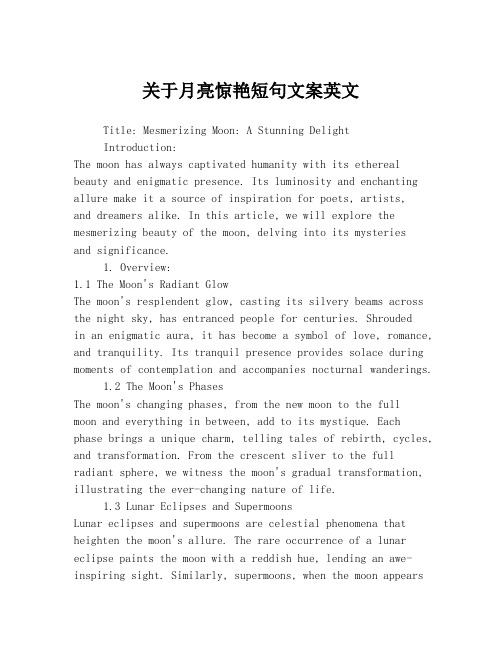
关于月亮惊艳短句文案英文Title: Mesmerizing Moon: A Stunning DelightIntroduction:The moon has always captivated humanity with its ethereal beauty and enigmatic presence. Its luminosity and enchanting allure make it a source of inspiration for poets, artists,and dreamers alike. In this article, we will explore the mesmerizing beauty of the moon, delving into its mysteriesand significance.1. Overview:1.1 The Moon's Radiant GlowThe moon's resplendent glow, casting its silvery beams across the night sky, has entranced people for centuries. Shroudedin an enigmatic aura, it has become a symbol of love, romance, and tranquility. Its tranquil presence provides solace during moments of contemplation and accompanies nocturnal wanderings.1.2 The Moon's PhasesThe moon's changing phases, from the new moon to the full moon and everything in between, add to its mystique. Each phase brings a unique charm, telling tales of rebirth, cycles, and transformation. From the crescent sliver to the full radiant sphere, we witness the moon's gradual transformation, illustrating the ever-changing nature of life.1.3 Lunar Eclipses and SupermoonsLunar eclipses and supermoons are celestial phenomena that heighten the moon's allure. The rare occurrence of a lunar eclipse paints the moon with a reddish hue, lending an awe-inspiring sight. Similarly, supermoons, when the moon appearslarger and closer to Earth, evoke a sense of wonder and admiration for the celestial wonders.1.4 Moon's Cultural SignificanceThe moon's cultural significance is deeply rooted in various traditions and beliefs worldwide. Many cultures perceive the moon as a deity or a guiding force. Lunar festivals celebrate the moon's beauty and mark important occasions, emphasizing unity, harmony, and gratitude.2. Moonlit Inspiration:2.1 The Moon's Influence on ArtsCountless artists have drawn inspiration from the moon, capturing its ethereal essence in paintings, sculptures, and poetry. From Vincent van Gogh's "Starry Night" to Claude Debussy's "Clair de Lune," the moon continues to weave its magic through various art forms, stirring emotions and contemplation.2.2 Romantic Notions and Moonlit TalesThe moon has long been associated with romance, provoking feelings of love and longing. Moonlit strolls, whispered promises, and stolen kisses under its gentle glow have become timeless moments that epitomize love's enchantment. Countless tales and myths revolve around the moon's involvement in love stories, capturing the hearts of many.3. Scientific Intrigue:3.1 Lunar Exploration and BeyondAdvancements in space exploration have allowed us to uncover the moon's secrets up close. Astronauts who have orbited and even walked on the moon have expanded our understanding of Earth's satellite. Scientific studies continue to delve into the moon's composition, geological history, and potential for future exploration.3.2 Impact on Earth's TidesThe moon's gravitational pull has a significant impact on Earth's tides, shaping our coastal landscapes and influencing marine ecosystems. The ebb and flow of the tides serve as a constant reminder of the moon's eternal presence and its connection to the natural world.Conclusion:The moon, with its astonishing beauty and mesmerizing splendor, continues to evoke a sense of wonder within us. Its luminous allure influences culture, art, and scientific exploration, leaving an indelible mark on human existence. As we gaze at the moon, its profound influence reminds us of our place in the vast universe, inspiring contemplation, creativity, and appreciation for the celestial wonders that surround us.。
MOONS' LED驱动器说明书

MU050S150BQI201 SPECIFICATIONS REVISION: A0oc No.: MSSD-6420 A0 LED DRIVER SPECIFICATIONSPart Description: Input:90AC~305V AC,Customer’s Part Number:MOONS’ Part Number: MU050S150BQI201Customer:Company:Department:Approved by:Date:EDITED: DATE:CHECKED: DATE:STANDARD: DATE:APPROVED: DATE:SHANGHAI MOONS’ AUTOMATION CONTROL Co., LTD.MU050S150BQI201 SPECIFICATIONS REVISION: A0 REVISIONS:Approved Rev. Date Descriptions ECONo. Edited CheckedA0 2017-04-20 New release Nisem◆Input voltage: 100-277Vac ,140-388Vdc◆Built-in active PFC function 0.95 Typ.◆High efficiency: up to 87% Typ.◆Constant current, 2 channels output ◆Output current can be set from 150~1500mA ◆AUX output 12V,150mA ◆Protection: OVP, SCP, OTP◆According with UL Class2、EN SELVEfficiency(230Vac)Efficiency(120Vac)Voltage RangeRated Input Voltage Frequency Range (Hz)Power Factor THDAC Current(Typ.)Inrush Current(Typ.)Input Power (W)Standby power (W)Leakage Current(max.)Output Voltage Range (V)Note.1Output Current Range(mA)Rated Power (W)Output channelsRipple Current (PK-PK)/AV Current Tolerance Line Regulation Load Regulation Setup, Rise Time AUX outputDimming Control Open circuit protection(V)Short CircuitOver Temperature Operating Temp.Operating HumidityStorage Temp., Humidity VibrationIngress Protection RatingIsolation Resistance EMC Emission EMC Immunity Life time MTBFDimension WeightVersion:A0MU050S150BQI201 Intelligent indoor LED driver■ SpecificationModel■ Features ◆2 channels 0-10V control◆4 in 1:Tunable white(1500-6500K).Dim to warm(1500-3200K),Solo dimming, Dual dimming0.55A MAX at 120VAC , 0.3A MAX at 230VAC50/60<20%, at 100~277Vac 50/60Hz input, with 50%~100% load conditions87%(Typical )at 100% load conditions>0.9 at 100~277Vac 50/60Hz input, with 50%~100% load conditions 90-305Vac , 126-427Vdc 0.75mA at 277Vac 60Hz input150-1500.Support hot plug, without overshoot current .(MU050S150BQI201 )<10A at 100~277Vac input 25℃ cold start at 100% conditions .for more details in the attached graph<0.5S @120V/60HZ, 230V/50HZ210% max, at output 700~1500mA conditions60(max)8-55<0.5W at input 120Vac, 230Vac Environment20~95%RH, non-condensing -25~+50℃ ( TBD)110℃±20%FCC Part 15 ClassB ,EN55015,EN61000-3-2 Class C ,EN61000-3-350(max)60Isolated 0-10V dimming / 0.1%Io~100%Io ref. Dimming module diagram and dimming curvePower supply stops output, recovers automatically when fault condition removed±5%87%(Typical )at 100% load conditions 408x 30 x 21 mm (LxWxH )±3%ProtectionInput100-277Vac , 140-388VdcNote.1: refer to V/I curve>50000@Tc =70℃(TBD) at 100% load conditions-40~+85℃, 10-95%RHPage 3 of 8I/P-O/P ,I/P-FG,O/P-FG:100M Ohms/500VDC/25℃/70%RH300,000 hours, measured at full load, 25℃ ambient temperature MIL-HDBK-217F(25℃)Safety & EMCEN61000-4-2,3,4,5,6,8,11,EN61547(Surge L,N-FG 2.5KV ,L-N 2.5KV )OthersUL8750, UL1012,UL1310 Class 2, CAN/CSA-C22.2No.107.1-01,EN61347-1, EN61347-2-131.5KV TBDAll Rights Reserved 2017-03-27 1.5KV 1.5KV1.875KV 1.5KV 1.5KVOutput12V± 3% ,150mA max10~500Hz, 5G 12min/cycle, period for 72min each along X 、Y 、Z axis±1%IP20Isolation Input Output Dimming interface Enclosure Enclosure No applicable Input No applicable 3.75KV 1.875KV Output 3.75KV No applicable 1.5KV Safety StandardDimming interface 1.5KV 1.5KV No applicableVersion:A0All Rights Reserved 2017-03-27Derating CurveSHANGHAI MOONS' AUTOMATION CONTROL CO., LTD.Tel: +86 (0)21 52634688 Website: Derating CurvePage 4 of 8■ CurveV/I CurveTBDTBDVersion:A0 ■ CurvePF VS. Load CurveTHD VS. Load CurveTBDTel: +86 (0)21 52634688 Website: Efficiency VS. Load CurveAll Rights Reserved 2017-03-27Page 5 of 8Input voltage120VAC 220VAC277VACTBD120220277163034213845264756325970407487Version:A0Tel: +86 (0)21 52634688 Website: Inrush current waveformAll Rights Reserved 2017-03-27Page 6 of 80-10V dim CurveIpeak■ Curve1.15Time@50% of Ipeak50us 2.4650us ItemInput voltage [VAC]Max number of drivers per MCB60usInrush current information Max. number of drivers MCB B type 10A MCB B type 13A MCB B type 16A MCB B type 20A MCB B type 25A2.851. MCS interface(MCS+/MCS-)●MCS+ interface voltage 15V●Max current setting(each step is 1 mA), default driving current defined as 350mA.●Log or linear dimming curve,default setting is linear.●NTC thermal management protects LED lamp,default setting is 70℃.●update Online,use smart key to connect PC and the driver to update the firmware.●When changed to any dimming level, flicker wouldn't occur,dimming would be achieved smoothly.●In the range of 300~1500mA,the current operating in continuous mode; In the range of 0~300mA,the current operating in PWM dimming mode, and the PWM frequency 4.8KHZ.3. Guide for setting driver’s parametersTouch settingProgram driver’s parameters quickly and easily through Near Field Communication. Software download link:/SouProduct/UCenter/M_Search/Software_view.aspx?MATNR=Touch%20Setting&rnd=2119Driver’s parameters can be set through SmartkeyII and Smartkey Network.What’s more,driver’s firmware can be updated through this tool.Softwar/SouProduct/UCenter/M_Search/Software_view.aspx?MATNR=Smartkey%20Network&rnd=21194. Tunable white, Dim to warm , Solo dimming , Dual dimming function introductionCH1CH2CH1CH2Solo dimming Dual dimming Version:A0●Touch Setting●Smartkey NetworkCold color channel Warm color channel All Rights Reserved 2017-03-27Page 7 of 8One 0-10V port control two output channels MURATA NTC ManufacturerVISHAY NTCLE100E3473NTCS0805e4473JXT NCP21WB473J03RA VISHAY 2. Dimming performanceNTC Model NO.MU050S150BQI201 Intelligent indoor LED driver■ Application of introductionNTCcompatibilitylist Two 0-10V ports control two output channelsTunable whiteCold color channel Control port DIM+CCTWarm color channel Dim to warm Control portDIMDimensions(Unit:mm)Port:Version:A0Normal connection usingSpecial connection usingRoHS Compliance:Our products comply with the European Directive 2002/95/EC, calling for the elimination of lead and other hazardous substances from electronic products.SHANGHAI MOONS' AUTOMATION CONTROL CO., LTD.Add: No.168, Mingjia Road, Minbei Industrial Park, Shanghai 201107, P.R.ChinaTel: +86 (0)21 52634688 Website: ■ Mechanical SpecificationAll Rights Reserved 2017-03-27Page 8 of 8MU050S150BQI201 Intelligent indoor LED driverGet larger output current through parallel connection.Support common anode connection.。
行星及月球英文版

Mars
What are Mars‘ features?
it is a small sized planet, half as large as Earth Mars is well visible to the naked eye Mars has two moons: Phobos and Deimos Mars has been visited by robotic vehicles:
But it is very difficult to spot them, since they are far far away.
Planets of other stars
How can planets of other stars be spotted?
There are two main ways that astronomers search for these planets:
Planets and Moons
Overview
This online lessons consists of the chapters
The Solar System The Planets Moons Planets of other stars More information: Links
In the middle of this disc, the Sun formed itself and began to glow.
In some distances from the centre, the planets emerged from these rings of dirt, rocks and gas.
They are quite small (<15km) and look rather like potatoes than like moons.
s开头的和星星有关的单词
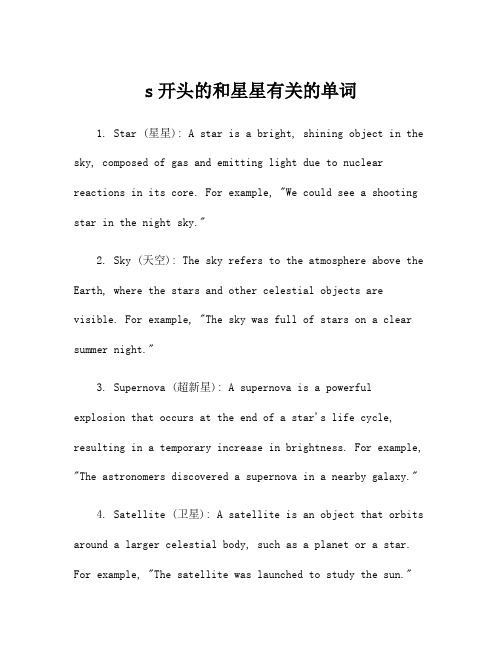
s开头的和星星有关的单词1. Star (星星): A star is a bright, shining object in the sky, composed of gas and emitting light due to nuclear reactions in its core. For example, "We could see a shooting star in the night sky."2. Sky (天空): The sky refers to the atmosphere above the Earth, where the stars and other celestial objects are visible. For example, "The sky was full of stars on a clear summer night."3. Supernova (超新星): A supernova is a powerful explosion that occurs at the end of a star's life cycle, resulting in a temporary increase in brightness. For example, "The astronomers discovered a supernova in a nearby galaxy."4. Satellite (卫星): A satellite is an object that orbits around a larger celestial body, such as a planet or a star. For example, "The satellite was launched to study the sun."5. Solar (太阳的): Solar refers to anything related to the sun. For example, "Solar energy is a renewable source of power."6. Science (科学): Science is a branch of knowledge that involves systematic study of the structure and behavior of the physical and natural world through observation and experiment. For example, "Astronomy is a fascinating field of science that explores the universe and stars."7. Space (太空): Space refers to the vast, seemingly infinite expanse that exists beyond the Earth's atmosphere. For example, "Astronauts travel to space on a spacecraft."8. Shooting star (流星): A shooting star is a quick streak of light that appears in the sky when a small piece of debris enters the Earth's atmosphere and becomes heated by friction. For example, "We made a wish as we saw a shooting star streak across the night sky."9. Solar system (太阳系): The solar system consists of the sun and all the celestial objects that orbit it,including planets, moons, asteroids, and comets. For example, "Our solar system has eight known planets."10. Stardust (星尘): Stardust refers to tiny particles of matter that are ejected into space from stars, and can eventually form new stars or other celestial objects. For example, "The telescope captured stunning images of stardust in a nearby galaxy."11. Starry-eyed (幻想的): Starry-eyed is an adjective used to describe someone who is overly idealistic or dreamy. For example, "She has always been starry-eyed about becominga famous actress."12. Sparkle (闪耀): Sparkle is a verb that means to shine brightly with flashes of light. For example, "Her diamond earrings sparkled under the chandelier."13. Stellar (恒星的): Stellar refers to anything related to stars or resembling a star. For example, "The telescope captured detailed images of the stellar formation."14. Satellite dish (卫星天线): A satellite dish is a device used to receive signals from communication satellites. For example, "The satellite dish on the rooftop allowed us to watch hundreds of channels."15. Spacecraft (航天器): A spacecraft is a vehicle designed for travel or operation outside the Earth's atmosphere. For example, "The spacecraft successfully landed on Mars."16. Stargazing (观星): Stargazing is the act of observing the stars and other celestial objects in the sky for recreational or scientific purposes. For example, "We spent the evening stargazing on a hilltop."17. Solar eclipse (日食): A solar eclipse occurs when the moon passes between the sun and the Earth, partially orcompletely blocking the sun's light. For example, "We put on eclipse glasses to watch the solar eclipse."18. Satellite navigation (卫星导航): Satellite navigation refers to the use of satellites to provide positioning and navigation services, such as GPS. For example, "The satellite navigation system helped us find our way in the city."19. Space exploration (太空探索): Space exploration is the discovery and investigation of celestial bodies and phenomena beyond the Earth's atmosphere. For example, "Space exploration has led to significant advancements in scientific knowledge."20. Star chart (星图): A star chart is a map of the night sky, showing the positions and names of stars and other celestial objects. For example, "We used a star chart to identify different constellations."21. Shimmer (闪烁): Shimmer is a verb that means to shine with a soft, flickering light. For example, "The stars shimmered in the reflection of the lake."22. Solar panel (太阳能电池板): A solar panel is a device that converts sunlight into electrical energy. For example, "Many houses have solar panels installed on their rooftops."23. Starstruck (为名人或明星而迷住): Starstruck is an adjective used to describe a feeling of being overwhelmed or infatuated by a celebrity or famous person. For example, "She was left starstruck when she met her favorite actor."24. Space shuttle (航天飞机): A space shuttle is a reusable spacecraft designed for transport between Earth and space, used by NASA from 1981 to 2011. For example, "The space shuttle mission was successful in deploying a satellite into orbit."25. Supernova remnant (超新星遗迹): A supernova remnant is the glowing, expanding debris left behind after asupernova explosion. For example, "The Hubble Space Telescope captured images of a supernova remnant in a distant galaxy."26. Solar wind (太阳风): Solar wind is the stream of charged particles emitted by the sun that flows through the solar system. For example, "The solar wind can affect the Earth's magnetic field and cause auroras."27. Star system (恒星系统): A star system is a group of stars that are gravitationally bound and often orbit around a common center of mass. For example, "The Milky Way galaxy contains billions of star systems."28. Space station (空间站): A space station is a large spacecraft designed to remain in orbit for extended periods of time, serving as a habitable and operational base for astronauts. For example, "The International Space Station is a collaborative project between multiple countries."。
关于月亮英文作文5篇_关于月亮的作文_
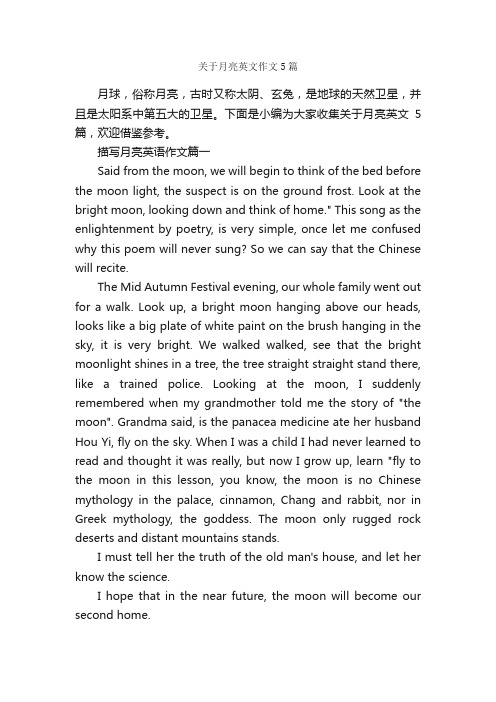
关于月亮英文作文5篇月球,俗称月亮,古时又称太阴、玄兔,是地球的天然卫星,并且是太阳系中第五大的卫星。
下面是小编为大家收集关于月亮英文5篇,欢迎借鉴参考。
描写月亮英语作文篇一Said from the moon, we will begin to think of the bed before the moon light, the suspect is on the ground frost. Look at the bright moon, looking down and think of home." This song as the enlightenment by poetry, is very simple, once let me confused why this poem will never sung? So we can say that the Chinese will recite.The Mid Autumn Festival evening, our whole family went out for a walk. Look up, a bright moon hanging above our heads, looks like a big plate of white paint on the brush hanging in the sky, it is very bright. We walked walked, see that the bright moonlight shines in a tree, the tree straight straight stand there, like a trained police. Looking at the moon, I suddenly remembered when my grandmother told me the story of "the moon". Grandma said, is the panacea medicine ate her husband Hou Yi, fly on the sky. When I was a child I had never learned to read and thought it was really, but now I grow up, learn "fly to the moon in this lesson, you know, the moon is no Chinese mythology in the palace, cinnamon, Chang and rabbit, nor in Greek mythology, the goddess. The moon only rugged rock deserts and distant mountains stands.I must tell her the truth of the old man's house, and let her know the science.I hope that in the near future, the moon will become our second home.一说起月亮,大家首先会想起“床前明月光,疑是地上霜。
MOONS' SPAC8两相步进电机驱动器 说明书
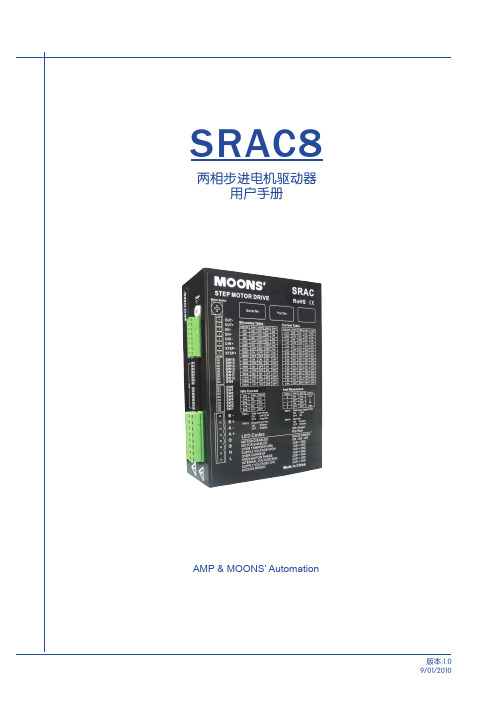
SRAC8两相步进电机驱动器用户手册AMP & MOONS’ Automation目录1 简介 (3)1.1 概述 (3)1.2 特性 (3)2 功能框图 (4)3 性能指标 (4)3.1 电气指标 (4)3.2 环境指标 (4)4 端口与接线 (5)4.1 安全须知 (5)4.2 电源连接 (6)4.3 电机连接 (7)4.4 反电势吸收电阻连接 (7)4.5 控制信号连接 (8)4.5.1 脉冲方向输入 (8)4.5.2 使能输入 (8)4.5.3 控制信号输入示例 (8)4.5.4 报错输出接口连接 (9)4.5.5 驱动器状态指示灯 (9)5 驱动器运行参数 (10)5.1 细分设定 (10)5.2 运行电流 (11)5.3 自动减流设定 (11)5.4 共振抑制 (12)5.5 脉冲输入模式 (12)5.7 平滑滤波 (12)5.8 自测 (12)6 电机设定 (13)6.1 推荐电机 (13)6.2 力矩曲线 (14)7 安装 (15)7.1 机械尺寸 (15)7.2 驱动器安装 (15)8 联系 MOONS’ (16)1 简介感谢您选择鸣志步进电机驱动器。
希望我们产品优越的性能、优异的质量和优秀的性价比可以帮助您成功的完成运动控制项目。
如果您对我们的产品有什么建议或者需要我们的帮助,请致电(86)21-52634688,或传真(86)21-62968682。
您也可以给我们发送邮件**************.cn。
1.1 概述SRAC8系列两相步进电机驱动器是基于PID电流控制算法设计的高性价比细分型驱动器,具有优越的性能表现,高速大力矩输出,低噪音,低振动,低发热,特别适合OEM客户的大批量应用场合。
SRAC8驱动器可通过拨码开关选择运行电流和细分,有16种细分,16种电流供选择,具有过压,欠压,相电流和总线电流过流保护,输入输出控制信号均采用光电隔离。
1.2 特性■供电电源 80-265VAC■输出电流 4位开关设定, 16 种选择,最大8安培(峰值)■电流控制先进的数字PID电流控制,高速大力矩输出■细分设置拨码开关设定,16种选择: 200, 400, 800, 1600, 3200, 6400, 12800,25600, 1000, 2000, 4000, 5000, 8000, 10000, 20000, 25000 步/转■速度范围选配合适的步进电机,最高可达3000rpm■共振抑制自动计算共振点,抑制中频振动■系统自检驱动器上电初始化自动检测电机参数并由此优化电机电流算法和抗共■振电子阻尼系数■细分插补拨码开关选定,可降低电机运转的振动,提高运行的平滑性■控制方式 1位开关设定,脉冲方向/ 双脉冲模式输入2种选择■输入滤波 2 MHz 或 150 KHz数字信号滤波器■空闲电流2位拨码开关选择,在电机停止运行后1秒电流会自动减为额定电流的25%,50%,75%或90%■产品自检拨码开关选择, 电机以1rps速度做两圈正反转往复运动■负载惯量根据应用场合不同,通过拨码开关选择高负载惯量或低负载惯量,使电机获得更平稳的运行性能2 功能框图3 性能指标3.1 电气指标驱动器参数Min.Typ.Max.Unit供电电压120VAC80-138VAC 220VAC150-265输出峰值电流120VAC0.4-8A 220VAC0.4-6步进脉冲宽度250--ns 方向信号宽度50--us欠压保护120VAC-80-VAC 220VAC-150-过压保护120VAC-155-VAC 220VAC-295-输入信号电压 4.0-28VOUT 导通电流--100mAOUT 承受电压--30V3.2 环境指标冷却方式自然冷却或强制冷却使用环境使用场合避免粉尘,油雾及腐蚀性气体工作环境温度-20°C-40°C [-4°F - 104°F]最高环境湿度90%RH(无结露)振动 5.9m/s² max存储温度-20-70°C [-4°F - 158°F]MicrostepIdle CurrentRun CurrentSelf Test Anti Resonance Load Intertia Select Input Digital Select4 端口与接线请参照接口关系图,使用SRAC8驱动器,需要做以下准备:80-265VAC 合适功率的交流电源控制信号源相匹配的步进电机,并安全接地(为取得最佳性能,请参考本用户手册第12页推荐的步进电机)4.1 安全须知1. 本交流输入驱动器工作电压范围超过人体耐受安全电压,所有接线必须在驱动器断电,电源指示 灯熄灭后方可进行。
描写月亮的英语高二
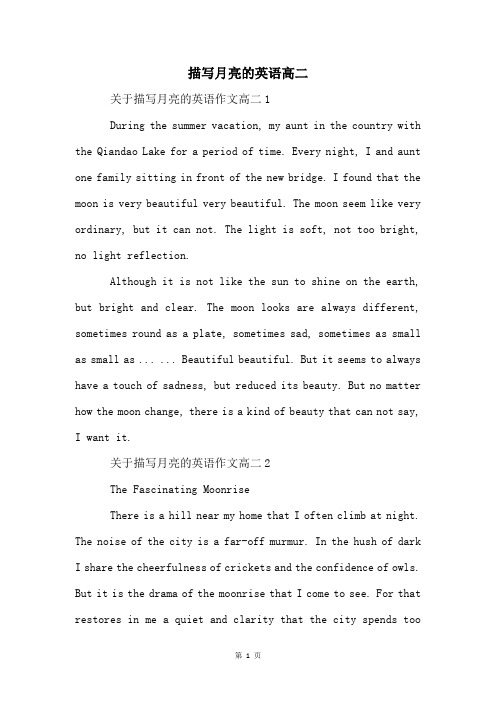
描写月亮的英语高二关于描写月亮的英语作文高二1During the summer vacation, my aunt in the country with the Qiandao Lake for a period of time. Every night, I and aunt one family sitting in front of the new bridge. I found that the moon is very beautiful very beautiful. The moon seem like very ordinary, but it can not. The light is soft, not too bright, no light reflection.Although it is not like the sun to shine on the earth, but bright and clear. The moon looks are always different, sometimes round as a plate, sometimes sad, sometimes as small as small as ... ... Beautiful beautiful. But it seems to always have a touch of sadness, but reduced its beauty. But no matter how the moon change, there is a kind of beauty that can not say, I want it.关于描写月亮的英语作文高二2The Fascinating MoonriseThere is a hill near my home that I often climb at night. The noise of the city is a far-off murmur. In the hush of dark I share the cheerfulness of crickets and the confidence of owls. But it is the drama of the moonrise that I come to see. For that restores in me a quiet and clarity that the city spends toofreely.From this hill I have watched many moons rise. Each one had its own mood. There have been broad, confident harvest moons in autumn; shy, misty moons in spring; lonely, white winter moons rising into the utter silence of an ink-black sky and smoke-smudged orange moons over the dry fields of summer. Each, like fine music, excited my heart and then calmed my soul. But we, who live indoors, have lost contact with the moon. The glare of street lights and the dust of pollution veil the night sky. Though men have walked on the moon, it grows less familiar. Few of us can say what time the moon will rise tonight. Still, it tugs at our minds.If we unexpectedly encounter the full moon, huge and yellow over the horizon, we are helpless but to stare back at its commanding presence. And the moon has gifts to bestow upon those who watch.I learned about its gifts one July evening in the mountains. My car had mysteriously stalled, and I was stranded and alone. The sun had set, and I was watching what seemed to be the bright-orange glow of a forest fire beyond a ridge to the east. Suddenly, the ridge itself seemed to burst into flame. Then, the rising moon, huge and red and grotesquely misshapenby the dust and sweat of the summer atmosphere, loomed up out of the woods. Distorted thus by the hot breath of earth, the moon seemed ill-tempered and imperfect. Dogs at nearby farmhouse barked nervously, as if this strange light had wakened evil spirits in the weeds.But as the moon lifted off the ridge it gathered firmness and authority. Its complexion changed from red, to orange, to gold, to impassive yellow. It seemed to draw light out of the darkening earth, for as it rose, the hills and valleys below grew dimmer. By the time the moon stood clear of the horizon, full-chested and round and of the colour of ivory, the valleys were deep shadows in the landscape. The dogs, reassured that this was the familiar moon, stopped barking. And all at once I felt a confidence and joy close to laughter.The drama took an hour. Moonrise is slow and serried with subtleties. To watch it, we must slip into an older, more patient sense of time.To watch the moon move inflexibly higher is to find an unusual stillness within ourselves. Our imaginations become aware of the vast distance of space, the immensity of the earth and the huge improbability of our own existence. We feel small but privileged.Moonlight shows us none of life’s harder edges. Hillsides seem silken and silvery, the oceans still and blue in its light. In moonlight we become less calculating, more drawn to our feelings.关于描写月亮的英语作文高二3As the Autumn Festival came, my family decided to asked my uncle and his families to come to my house and spent this day together. I was so happy. Early in the morning, my cousins came, then we played around the house. Our parents were busy in the kitchen. There must be delicious food for us to share. When it got dark, all the people stood in the balcony. We talked and played the game, waiting for the biggest moon. It was such a beautiful moment. We did not do this often, because the parents were busy with their work all the time. At about eight o’cloc k, the moon became very clean, and it lighted up the whole world. I ate the moon-cake and saw people celebrated in their ways. Some people made a wish by lighting a Kongming lantern, making the sky look wonderful.关于描写月亮的英语作文高二4About Mid-Autumn Festival, the annual celebrations include many ingredients such as eating mooncakes, lighting lanterns, fire dragon dance, family dinner and enjoying themoonlight....Talking about enjoying the midnight moon and eating mooncakes in Mid-Autumn day(中秋赏月zhōngqiūshǎngyuè) , there is a sad love story behind the mooncakes, its about houyi(后羿) and change(嫦娥).Who is houyi?He is a mythological hero in Chinese literature.Houyi was a skilled archer in 2100BC and his story happened in the ancients. There were ten suns in the sky at that time, which were actually birds – sun-birds. One day, the sun-birds decided to fly, all ten of them, across the sky. Then the earth started scorching , crops were withered and people were thirsty to die. Houyigraciously shot down nine of the ten birds and remained one, saving the earth, and was rewarded with a pill that would grant eternal life.关于描写月亮的英语作文高二5Said from the moon, we will begin to think of the bed before the moon light, the suspect is on the ground frost. Look at the bright moon, looking down and think of home. This song as the enlightenment by poetry, is very simple, once let me confused why this poem will never sung? So we can say that the Chinese will recite.The Mid Autumn Festival evening, our whole family went out for a walk. Look up, a bright moon hanging above our heads, looks like a big plate of white paint on the brush hanging in the sky, it is very bright. We walked walked, see that the bright moonlight shines in a tree, the tree straight straight stand there, like a trained police. Looking at the moon, I suddenly remembered when my grandmother told me the story of the moon. Grandma said, is the panacea medicine ate her husband Hou Yi, fly on the sky. When I was a child I had never learned to read and thought it was really, but now I grow up, learn fly to the moon in this lesson, you know, the moon is no Chinese mythology in the palace, cinnamon, Chang and rabbit, nor in Greek mythology, the goddess. The moon only rugged rock deserts and distant mountains stands.I must tell her the truth of the old mans house, and let her know the science.I hope that in the near future, the moon will become our second home.一说起月亮,大家首先会想起“床前明月光,疑是地上霜。
月亮的美丽景色(中英文翻译)
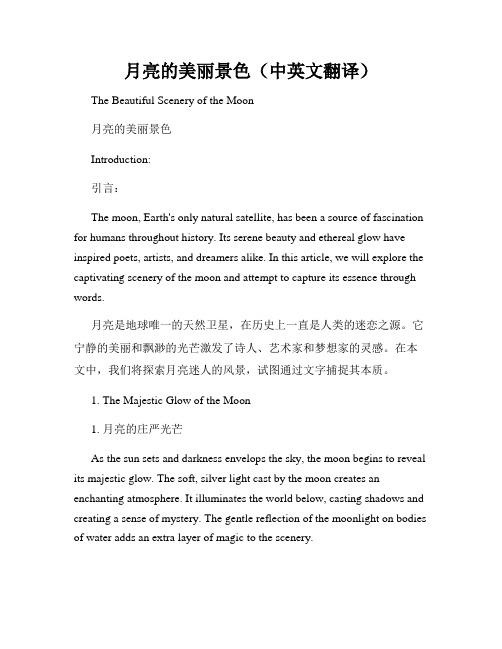
月亮的美丽景色(中英文翻译)The Beautiful Scenery of the Moon月亮的美丽景色Introduction:引言:The moon, Earth's only natural satellite, has been a source of fascination for humans throughout history. Its serene beauty and ethereal glow have inspired poets, artists, and dreamers alike. In this article, we will explore the captivating scenery of the moon and attempt to capture its essence through words.月亮是地球唯一的天然卫星,在历史上一直是人类的迷恋之源。
它宁静的美丽和飘渺的光芒激发了诗人、艺术家和梦想家的灵感。
在本文中,我们将探索月亮迷人的风景,试图通过文字捕捉其本质。
1. The Majestic Glow of the Moon1. 月亮的庄严光芒As the sun sets and darkness envelops the sky, the moon begins to reveal its majestic glow. The soft, silver light cast by the moon creates an enchanting atmosphere. It illuminates the world below, casting shadows and creating a sense of mystery. The gentle reflection of the moonlight on bodies of water adds an extra layer of magic to the scenery.当太阳落山,黑夜笼罩天空时,月亮开始展现其庄严的光芒。
月亮主题的英文作文500字
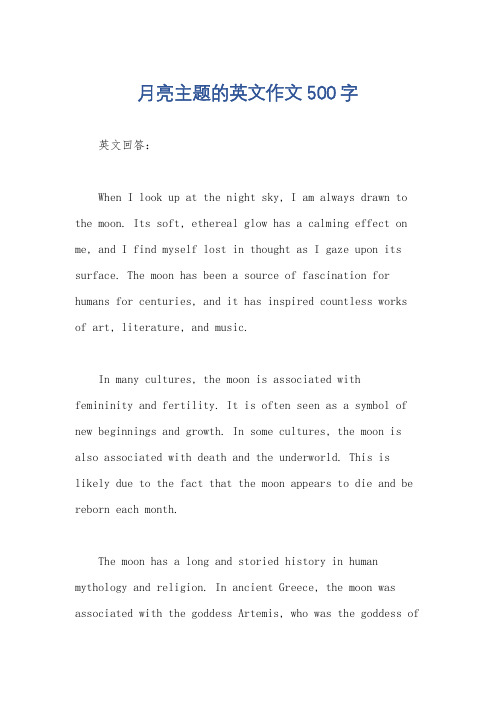
月亮主题的英文作文500字英文回答:When I look up at the night sky, I am always drawn to the moon. Its soft, ethereal glow has a calming effect on me, and I find myself lost in thought as I gaze upon its surface. The moon has been a source of fascination for humans for centuries, and it has inspired countless works of art, literature, and music.In many cultures, the moon is associated withfemininity and fertility. It is often seen as a symbol of new beginnings and growth. In some cultures, the moon is also associated with death and the underworld. This is likely due to the fact that the moon appears to die and be reborn each month.The moon has a long and storied history in human mythology and religion. In ancient Greece, the moon was associated with the goddess Artemis, who was the goddess ofthe hunt, the moon, and childbirth. In ancient Rome, the moon was associated with the goddess Luna, who was the goddess of the moon and the night. In many Native American cultures, the moon is seen as a powerful spirit thatcontrols the tides and the seasons.The moon has also been a source of scientificfascination for centuries. In the 16th century, Nicolaus Copernicus proposed that the Earth revolves around the sun, not the other way around. This theory was later confirmedby Galileo Galilei, who used a telescope to observe the moons of Jupiter. In the 20th century, Neil Armstrong and Buzz Aldrin became the first humans to walk on the moon.Today, the moon continues to be a source of fascination for both scientists and laypeople alike. Scientists are studying the moon in order to learn more about its composition, its history, and its potential for future exploration. Laypeople are drawn to the moon because of its beauty, its mystery, and its connection to our own humanity.中文回答:当仰望夜空时,我总会被月亮吸引。
彩虹与月亮的英语作文
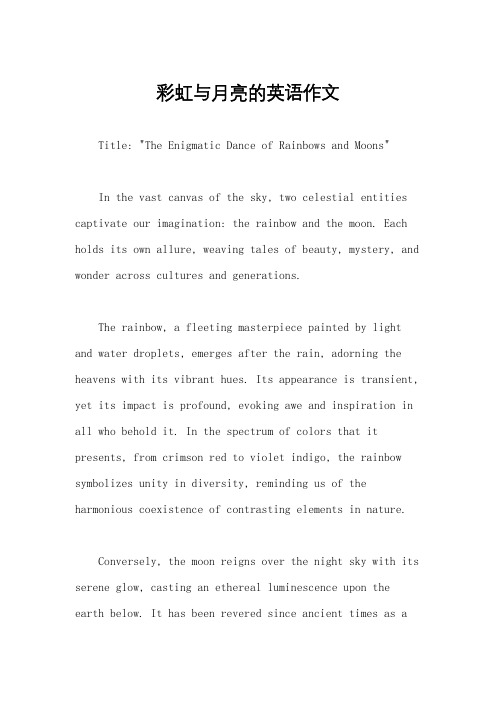
彩虹与月亮的英语作文Title: "The Enigmatic Dance of Rainbows and Moons"In the vast canvas of the sky, two celestial entities captivate our imagination: the rainbow and the moon. Each holds its own allure, weaving tales of beauty, mystery, and wonder across cultures and generations.The rainbow, a fleeting masterpiece painted by light and water droplets, emerges after the rain, adorning the heavens with its vibrant hues. Its appearance is transient, yet its impact is profound, evoking awe and inspiration in all who behold it. In the spectrum of colors that it presents, from crimson red to violet indigo, the rainbow symbolizes unity in diversity, reminding us of the harmonious coexistence of contrasting elements in nature.Conversely, the moon reigns over the night sky with its serene glow, casting an ethereal luminescence upon the earth below. It has been revered since ancient times as asymbol of mystique and contemplation, its phases marking the passage of time and the rhythms of nature. From the crescent moon, reminiscent of a delicate silver sickle, to the full moon, radiant and resplendent in its entirety, each phase holds its own allure, inviting introspection and reflection.Though seemingly disparate, the rainbow and the moon share a profound connection rooted in the interplay oflight and atmosphere. The rainbow, born from the refraction and reflection of sunlight through raindrops, relies on the same principles of optics that lend the moon its luminous glow. In this sense, they are kindred spirits, manifestations of the intricate dance between celestial bodies and the natural elements.Moreover, both the rainbow and the moon have inspired countless myths, legends, and cultural beliefs across civilizations. In folklore, the rainbow is often portrayed as a bridge between the mortal realm and the divine, a pathway traversed by gods and spirits. Similarly, the moon is imbued with symbolic significance, associated withdeities, fertility rites, and lunar cycles that govern agricultural practices and spiritual ceremonies.Yet, for all their splendor and symbolism, the rainbow and the moon also remind us of the impermanence and transience of beauty. The rainbow, fleeting and ephemeral, dissipates as swiftly as it appears, leaving behind only memories and photographs as mementos of its brilliance. Likewise, the moon waxes and wanes in a perpetual cycle of renewal, its phases serving as a reminder of the cyclical nature of existence.In conclusion, the enigmatic dance of rainbows and moons transcends mere celestial phenomena, encompassing themes of beauty, symbolism, and impermanence. Whether gazing upon the iridescent arc of a rainbow or the silvery glow of the moon, we are reminded of the boundless wonders of the universe and our place within it. As we marvel at these celestial spectacles, let us cherish the fleeting moments of magic they bestow upon us, for in their brilliance, we find solace, inspiration, and a profound connection to the cosmos.。
MOONS S Series Intelligent 0-10V DALI DMX驱动程序设置手册说

I.Introduction1)All MOONS’ S Series Intelligent (0-10V, DALI, DMX) Driver can be programmed through SmartkeyII/ Smartkey A1 and Smartkey Network Software.Such as dimming solution, output current value, minimum dimming level, dimming curve, etc.2)This user manual was written for:Smartkey Network Software;Smartkey II (Firmware version ≧2.0) that only supports charged mode;Smartkey A1 that supports uncharged programming mode and charged programming mode;All MOONS’ S Series Intelligent (0-10V, DALI, DMX) Drivers;3)There are two main documents in the software package.Folder “Smartkey Network” : the free-install software.The file “CDM v2.12.00 WHQL Certified.exe” : the USB driver of Smartkey II.II.Operating System Requirement△Operating system should be senior to Windows 7 (Including Windows 7)△.NET Framework version 4.0 or senior version; (.NET Framework is the part of your operating system; It also can be download from the Microsoft official website.)△The USB driver of Smartkey II/A1 should be installed on the operating system.Run “CDM v2.12.00 WHQL Certified.exe” as Administrator right and install the USB driver on your computer.III.Hardware Wring ConnectionAll MOONS’ Intelligent Driver can be programmed through MCS±port by Smartkey II/Smartkey A1 and Smartkey Network Software.Charged programming methodUncharged programming methodDimming Port List (Only for Dual 0-10V driver):Dimming Solution Dimming PortTunable White CCT Port: CCT changing; DIM Port: Intensity changing;Channel 1 is connected to Cool LEDs, Channel 2 is connected to Warm LEDs; Dim to Warm DIM Port: CCT & Intensity changing;Channel 1 is connected to Cool LEDs, Channel 2 is connected to Warm LEDs; Solo 0-10V Dimming DIM Port: Intensity changing;Dual 0-10V Dimming CCT Port: control Ch2’s intensity; DIM Port: control Ch1’s intensity;IV.Guide for programming Intelligent driver.1)Activate software interface.i)Double Click SmartKeyTool that in the folder “Smartkey Network V1.9”ii)Click Settingiii)Choose “One Wire” and then Click “OK”iv)Click “Read” to activate software interface.Click “Save” to program driver’s configuration.Software Interface2)Programming DALI driverDevice InformationDevice Type Change driver’s type.Solo: use one address to control two channels simultaneouslyDual: use two addresses to control two channels respectivelyDT8 CCT: use one address to achieve tunable whiteDT6 CCT: achieve tunable white through two addresses, one address tocontrol CCT, another address to control intensity.Firmware Version The firmware version of driver.Dimming Curve Set driver’s dimming curve to be liner or logarithmic.Minimum Level Set driver’s minimum dimming level.The valid range of logarithmic dimming curve: 0.1%~100%.The valid range of linear dimming curve: 0.4%~100%, the minimumadjustable unit is 1/254;Current SettingCH1,CH2 Set driver’s output current.In order to achieve accurate CCT range, please keep CH1=CH2.Power Output Enable Enable or disable DALI power output on the driver. 15V-100mA.Physical Warmest, Physical Coolest Set driver’s CCT range according to fixture.The valid range is 1500~6500K.In order to achieve accurate CCT range, please set driver’s CCT rangeaccording to fixture’s actual CCT range.3)S Series Dual 0-10V driver has four dimming solutions.i)Tunable White (0-10V CCT Driver)The Color Temperature & Intensity tuning can be achieved by MOONS' Dual 0-10V Driver & Standard 0-10V dimmer; 0-10V dimming Channel(A)——Color Temperature Tuning; 0-10V dimming Channel (B)——Intensity ChangingDevice InformationDevice Type Change driver’s dimming solution.Firmware Version The firmware version of driver.Dimming Curve Set driver’s dimming curve to be liner or logarithmic.Minimum Level Set driver’s minimum dimming level.The valid range of logarithmic dimming curve: 0.1%~100%.The valid range of linear dimming curve: 0.4%~100%, the minimumadjustable unit is 1/254;Current SettingCH1,CH2 Set driver’s output current.In order to achieve accurate CCT range, please keep CH1=CH2.Max Volt (7~10V) Set the voltage of dimming signal at 100% intensity & coolest CCT.e.g. If the driver’s max volt is set to be 8V.The driver will keeps 100% intensity as long as the dimming signal’svoltage ≧8V.The driver will keeps coldest CCT as long as the dimming signal’svoltage ≧8V.CCTPhysical Warmest, Physical Coolest Set driver’s CCT range according to fixture.The valid range is 1500~6500K.In order to achieve accurate CCT range, please set driver’s CCT rangeaccording to fixture’s actual CCT range.Fade TimeIntensity Fade Set the fade time of intensity changing.The Valid range is 150~1000 ms, the minimum adjustable unit is 50ms.If the value is set to be 800ms, driver will cost 800ms to achieve intensityB from intensity A.CCT Fade Set the fade time of CCT changing.The Valid range is 150~1000 ms, the minimum adjustable unit is 50ms.If the value is set to be 500ms, driver will cost 500ms to achieve CCT Bfrom CCT A.ii)Dim to Warm (0-10V Dim to Warm Driver)Dimming like incandescent light bulb, change a luminaire’s color temperature when dimmed.Note: For the explanation of Device Information, Current Setting, CCT, Fade Time, please refer to i) Tunable White (0-10V CCT Driver)Logical CCT Rang ≤Physical CCT RangeDim to WarmWarmest Level The intensity level of corresponding warmest CCT.Logical Warmest The warmest CCT driver can achieve.The valid range: 1500~3200K.Assume that the warmest level is set to be 10%, warmest is set to be 2200K.The driver will keep CCT at 2200K as long as the intensity is≦10%.Coolest Level The intensity level of corresponding coolest CCT.Logical Coolest The warmest CCT driver can achieve.The valid range: 1500~3200K.Assume that the coolest level is set to be 80%, coolest is set to be 2700K.The driver will keep CCT at 2700 as long as the intensity is ≧80%.Intensity Ratio Intensity Ratio=Warmer LED’s power ÷Cooler LED’s powerMax Volt (7~10V)Set the voltage of dimming signal at 100% intensity.e.g. If the driver’s max volt is set to be 8V.The driver will keeps 100% intensity as long as the dimming signal’svoltage ≧8V.iii)Solo 0-10V Dimming (0-10V Solo Driver)Setting different current value of each output channel, perform broadcast dimming by single 0-10V dimming signal.Note: For the explanation of Device Information, Current Setting, Max V olt, Fade Time, please refer to i) Tunable White (0-10V CCT Driver)iv)Dual 0-10V Dimming (0-10V Dual Driver)Dim each channel to different intensity by dual 0-10V dimming signal individually.Note: For the explanation of Device Information, Current Setting, Max V olt, Fade Time, please refer to i) Tunable White (0-10V CCT Driver)4)Programming DMX driverThere are three dimming solutions in the DMX 2 channels driver:DMX CCT: achieve tunable white through two DMX addresses, one address to control CCT, another DMX address to control intensity.DMX Solo: use one address to control two channels simultaneously.DMX Dual: use two addresses to control two channels respectively.DMX CCT modeDevice Type Change driver’s dimming mode: Solo, Dual, CCTFirmware Version Check driver’s firmware versionDiming Curve Chang driver’s dimming curve: Linear or GammaMinimum Level Set the minimum dimming level: 0.1~100%NTC Set the temperature value of NTC.DMX Address Set driver’s start addressCurrent Setting Set driver’s output current valuePhysical CCT Set the physical CCT range according to fixture’s actual color temperature.Logic CCT Set the logic CCT range according to actual requirement.Notes: the Logic CCT range ≤the Physical CCT rangePower on level The intensity the driver outputs, when there is no dimming signal during starting process.Power on CCT The CCT the driver achieves, when there is no dimming signal during starting process.Failure level The intensity the driver outputs, when the driver loses the dimming signal.Hold means the driver will keep the previous intensity level when the driver loses the dimmingsignal.The valid range: 0~100%, Hold.Failure CCT The CCT the driver outputs, when the driver loses the dimming signal.Hold means the driver will keep the previous CCT level when the driver loses the dimming signal.The valid range: logic CCT range, Hold.Delay time Set the time to trigger “Failure level” and “Failure time” mode.DMX Solo mode, DMX Dual mode: please refer to above list.。
make_moons函数
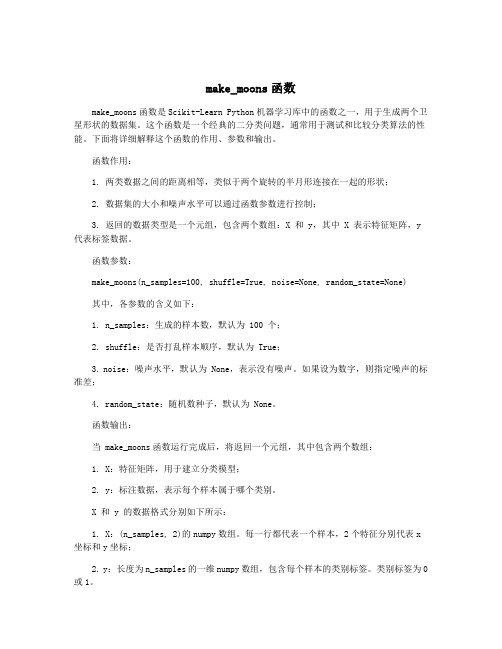
make_moons函数make_moons函数是Scikit-Learn Python机器学习库中的函数之一,用于生成两个卫星形状的数据集。
这个函数是一个经典的二分类问题,通常用于测试和比较分类算法的性能。
下面将详细解释这个函数的作用、参数和输出。
函数作用:1. 两类数据之间的距离相等,类似于两个旋转的半月形连接在一起的形状;2. 数据集的大小和噪声水平可以通过函数参数进行控制;3. 返回的数据类型是一个元组,包含两个数组:X 和 y,其中 X 表示特征矩阵,y 代表标签数据。
函数参数:make_moons(n_samples=100, shuffle=True, noise=None, random_state=None)其中,各参数的含义如下:1. n_samples:生成的样本数,默认为 100 个;2. shuffle:是否打乱样本顺序,默认为 True;3. noise:噪声水平,默认为 None,表示没有噪声。
如果设为数字,则指定噪声的标准差;4. random_state:随机数种子,默认为 None。
函数输出:当 make_moons函数运行完成后,将返回一个元组,其中包含两个数组:1. X:特征矩阵,用于建立分类模型;2. y:标注数据,表示每个样本属于哪个类别。
X 和 y 的数据格式分别如下所示:1. X:(n_samples, 2)的numpy数组。
每一行都代表一个样本,2个特征分别代表x 坐标和y坐标;2. y:长度为n_samples的一维numpy数组,包含每个样本的类别标签。
类别标签为0或1。
样例代码:下面是一个使用 make_moons函数生成卫星形状数据集的示例代码:# 观察生成的数据import matplotlib.pyplot as pltplt.scatter(X[:,0], X[:,1], c=y, cmap=plt.cm.Spectral)plt.show()```上面的代码首先调用 make_moons函数生成包含1000个样本的卫星形状数据集,其中设置了一些参数以控制生成的数据集大小和噪声水平。
